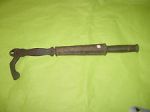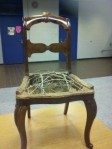Once a week I lug my most recent garage sale find through the back door of our local public school cafeteria, and spend three hours excavating and reconstructing it. This upholstery class is a well-known secret in our community: it used to be taught by a local master. When he passed away his son took over. The son moved down south last year, so now a 10-year veteran of the class is offering it as an upholstery collaborative. The class has always kind of run this way: you heave your piece onto a lunch table and start going at it. The teacher roams through the neon-lit space, helping when you hit a snag, offering materials you don’t have, and problem-solving with you. When a “teachable moment” arises, other collaborators gather ’round to weigh in, learn by watching, and rest their weary hands. Because upholstery is a healthy combination of high craft and manual labor. And therein lies the beauty.
The chair I’m working on now is bare. Last week I stripped it of its padded palimpsest of previous generations. Along the edges of the seat frame, where fabric will once again nuzzle up against wood, there are regular rows of tack tracks, peppered with the less regular but more insistent staple bites of more recent artisans. Like the rings of a felled tree, you uncover historical layers once you start to bare the bones of your chair. Layers of horsehair, cotton batting, fabric remnants, and synthetic fibers can often all be found inside a rich dig. One of the unspoken rules of true upholstery is if it doesn’t smell, re-use it. This is not a precious group: we practice a tradition that was green and DIY before either of those things mattered. It’s also practical: so you’ve pulled most of the fabric across the seat, and see a spot that isn’t quite even with the other side? no worries, stuff in a little extra cotton. It will look fine, no one will ever know. When you uncover a shortcut taken by the last person who saw your chair naked, you feel admitted into a secret club.
As a dying craft, many tools of the trade are almost impossible to find. Recently, one of us was using a vertical staple gun to stabilize the springs on a lovely bench. That thing looks like a torture device that would have made the masters of the inquisition blanche. That bench gave up its secrets quietly. And did you know that those electric carving knives that were the pride of the 50’s are very effective at cutting through foam? I recently found a webbing stretcher at an estate sale – score! It wasn’t labeled: i’m sure no one knew what it was. Can’t wait to tell my secret society.

I’m actually glad the class has turned into a collaborative. I feel like I’m continuing a tradition of women’s work (though most upholsterers these days are men, such was not always the case). We help one another out; share stories; laugh through mistakes; and cheer when a piece is completed. We have had male students too, but the mood in the room is female. LIke many occupations that seem to be relegated to the home, and so to women, the reality of the work is quite different. Only a small part of upholstery has anything to do with what you see – fabric, color, and style. Much more time is spent on staples and nails, wood hardener and hammers. You know, girl stuff. After hours or days whacking the materials into position; solving the mathematical equations needed to measure materials; and pulling and stretching to get a good seat, you spend a matter of minutes tacking on the edging (to cover the staples). Isn’t she pretty?
Sometimes someone wanders into our group by mistake (there are two cafeterias at the school; soccer sign up is in the other one), and they look curious and intrigued. We always invite them to sign up; sometimes they do. How often can you join a decorating rebellion, learn about history and yourself, for $50. Our secret society feels both inclusive and rebellious. We’ve all made deals to be there – with partners, work, children, or ourselves – and this negotiated time is precious. We don’t just want to decorate our homes, though we want to do that, but we also want to feel a part of history, learn about one another. I know that my (white) teacher was in this same school the day MLK Jr. was shot, and some (black) classmates shoved her up against a radiator, leaving marks on her knees she still has. I know that for most of those in the class, a $150 electric stapler that makes the work so much faster and less physically painful, is beyond reach, so they muscle through it with the $40 version with a shrug. And I know that there are just as many hard decisions that went into a chair that I think looks just as ugly going out as it did coming in.
Why learn how to take apart and build back up furniture that could be just as easily replaced by something from IKEA. Because the process is the bargain, not the finished product. Sure, the old chair with the new fabric looks great. But it feels great to figure it out, to feel part of a tradition, to have 3 hours away from Twitter, and Facebook, and family to zone out as you yank, or confer with colleagues about whether the welting should be on the bias or not. Upholstery is an act of transformation not only for the piece of furniture but the person that works on it.

